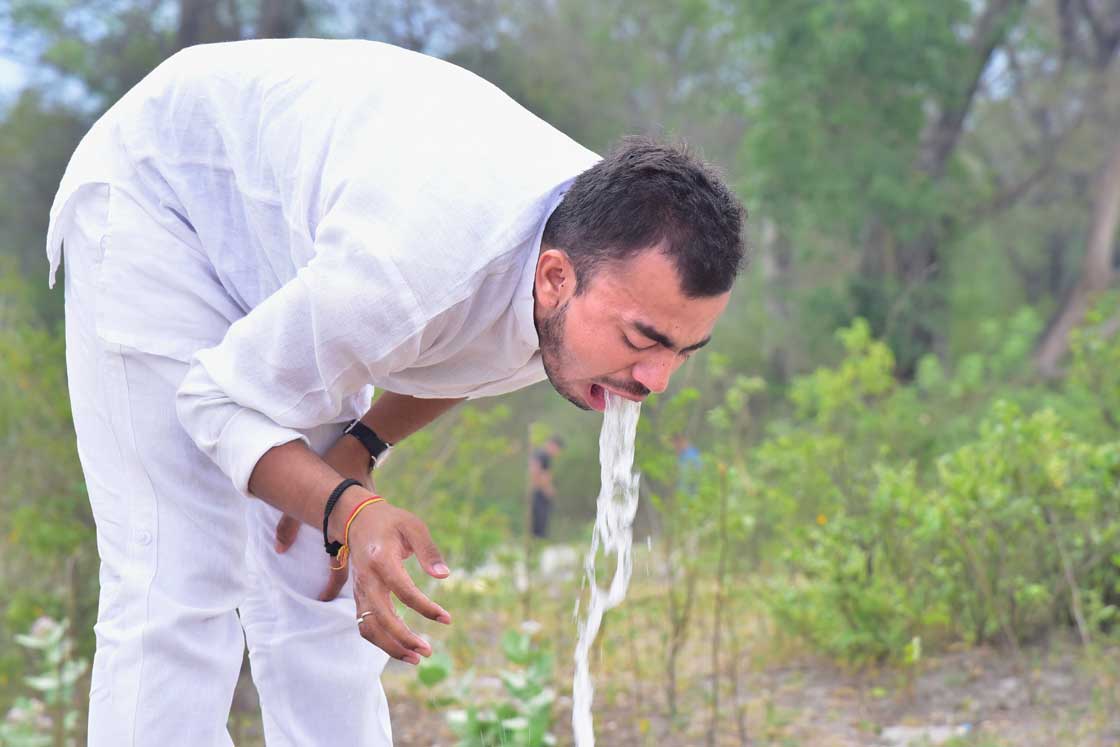
Shatkarma, the six purification methods of Hatha Yoga, are designed to cleanse the internal body and prepare it for higher yogic disciplines. Among these, Dhauti kriyas are aimed at the digestive tract, helping eliminate waste, mucus, and impurities that interfere with digestion and mental focus. Kunjal Kriya or Vaman Dhauti is related techniques that use induced vomiting to cleanse the upper stomach region. While the process appears similar, they differ in purpose, timing, and application. A clear understanding of both practices allows yoga practitioners to choose the method best suited to their needs.
What is kunjal kriya?
Kunjal Kriya is a traditional cleansing practice from Hatha Yoga, used to flush out impurities from the upper digestive tract through controlled, voluntary vomiting.
In this technique, a large amount of lukewarm saline water is consumed beyond the stomach’s normal capacity. After keeping it in the stomach for a few moments, the water is expelled by stimulating the gag reflex, typically using the fingers. This helps release mucus, toxins, and undigested food particles from the stomach lining.
Kunjal Kriya is especially useful for relieving acidity, bloating, and digestive discomfort. As described in the Gheranda Samhita, regular practice may also support the functioning of the liver and spleen. By removing stagnant food residues, the kriya prevents the buildup of am a sticky, toxic substance in Ayurveda considered a root cause of many health issues.
What is vaman dhauti?
Among the six Shatkarmas (purification techniques) described in yogic texts, Dhauti is listed as the first and foremost. The term Dhauti literally means “washing” or “cleansing.” This kriya is further classified into four types, each designed to purify different sections of the upper digestive system.
Vaman dhauti is a similar practice to kunjal kriya where the content of the stomach is thrown by induced vomiting. It’s also called vyaghra kriya (tiger-like action); Just as a tiger vomits its food after a few hours of eating it, in the same way, vomiting is done in the Vaman dhauti to flush out undigested food particles. Vaman dhauti is also known as ‘Jala dhauti‘ and ‘Gaja karni kirya‘.
However the procedure of both kriyas are identical, the difference is based on the timing and purpose. Vaman dhauti is done after 3 or 4 hours of having a meal whereas kunjal kriya is a morning practice that is advised to perform on empty stomach.
How to do Kunjal kriya(steps)
Kunjal Kriya or Vaman Dhauti is traditionally performed early in the morning on an empty stomach. It involves drinking a large quantity of lukewarm saline water followed by induced vomiting to cleanse the upper digestive tract. Follow these step-by-step instructions:
- Prepare a bottle of lukewarm saline water
- Drink water in a sitting position
- Perform abdominal moments
- Induce throat to vomit
- Relax in Shavasana
1. Prepare lukewarm saline water
Heat 1.5 to 2 litres of pure drinking water to body temperature (around 37°C).
Add 1 teaspoon of salt per litre and mix well. Beginners may use up to 2 teaspoons to trigger nausea more easily.
Keep the water in a bottle or large container with a glass ready for quick drinking.
2. Drink the water (seated position)

Sit in a squatting position, keeping the knees apart so the abdomen is not compressed.
Begin drinking the saline water quickly but calmly, aiming to consume about 1 litre without pause.
Take a short break, then drink the remaining water. Stop once your stomach feels completely full and a sense of nausea sets in. This signals readiness for the next step.
Now, stand up straight to begin the cleansing phase
3. Perform abdominal moments
Perform abdominal moments to let the water moments well inside the stomach so that cleansing would be more effective.
Fastly expand and contract abdominal muscles a few times, just as if you are performing Uddiyana Bandha. Now, when you start feeling straining because of the weight of the water into the stomach, you ready to throw it out.
4. Induce throat to vomit out water

Bend your trunk forward at 90° angle while keeping feet at a distance of 1 to 1.5 ft.
Now, press your ‘stomach in’ with exhalation in the same bending position. At the same time, insert your index and middle finger of the right hand deep down into the throat.
Generally, a little pressure of finger at the end of the tongue is enough to induce vomit.
Inducing let the water come out in gushes but sometimes it comes out in a small amount in the beginning. Water comes out in tasteless & yellowish colour in beginning but after a few gushes, water comes out comparably bitter in taste. This shows undigested residue has eliminated completely in the process.
In the end of kunjal kriya, drink one glass of water for final cleansing.
5. Relax in Shavasana
After completing the drinking procedure, wash your mouth and face with clean water. relax your body in Shavasana for 10-15 minutes. after that, you can continue daily routine work or asana practice.
One should take food at least one hour after completing the kunjal kriya. Eat rice pudding or take sweet milk to get abdominal organs back in its working.
Contraindications
Kunjal Kriya should be avoided in certain physical conditions where the practice may lead to discomfort or adverse effects. It is contraindicated in the following cases
- Avoid during pregnancy or menstruation, as the practice may strain the abdominal region.
- Do not perform if you have a stomach hernia, as induced vomiting can worsen the condition.
- Individuals with heart disease should refrain from this kriya due to the risk of increased cardiac stress.
- Hematemesis (vomiting of blood) is a serious condition and makes this practice unsafe.
- Those with abdominal tumours should avoid this technique, as it may aggravate internal pressure and cause complications.
Precautions
- Try to expel as much of the water as possible during vomiting. Retained water may lead to acidity or discomfort later.
- Check the temperature of the water before drinking. It should be lukewarm neither too hot nor too cold.
- Individuals with high or low blood pressure, respiratory issues, or peptic ulcers should avoid this kriya.
- Trim your fingernails before inserting fingers into the throat to prevent injury to the mouth or throat lining.
Kunjal kriya(vaman dhauti) benefits
After performing Kunjal Kriya or vaman dhauti, many practitioners notice an immediate feeling of lightness in the stomach and clarity in the head. Over time, this practice supports various systems in the body not just digestion.
Below are some of the key benefits experienced through regular and mindful practice.
- Enhances digestion – Kunjal Kriya temporarily reduces the load on the digestive system, allowing it to reset. It stimulates the digestive organs, increases appetite, and provides relief from indigestion and constipation.
- Strengthens respiratory system – The act of induced vomiting strengthens the respiratory muscles and lowers airway resistance. This helps improve lung function and supports the management of bronchial asthma, bronchitis, and other pulmonary disorders.
- Clears skin – Regular practice is known to clear skin conditions such as acne, itching, and eczema. Many yogis observe a natural glow in the skin and a delay in the signs of aging with consistent kriya practice.
- Balance Kapha and pitta dosha – This kriya is especially beneficial for those struggling with weight gain, allergies, fluid retention, fatigue, insomnia, and depression conditions often linked to imbalanced Kapha and Pitta doshas. Kunjal Kriya clears excess mucus, phlegm, and harmful bacteria from the stomach lining, restoring doshic balance.
- Helps in weight loss – By neutralising excessive stomach acid, Kunjal Kriya reduces unnatural hunger and excessive thirst, which can contribute to obesity. Additionally, the muscular contractions during the kriya help tone abdominal muscles, aiding in weight management.
Kunjal Kriya FAQs
It’s not recommended to practice kunjal kriya daily, however, if you’re feeling acidity, indigestion, or burning sensation continuously, it can be done on consecutive days. A healthy person should keep the frequency of kunjal kriya once a week.
Blood in kunjal kriya vomit could have several reasons. It happens sometimes due to nail scratches in the throat (especially in the case of a small child who has delicate skin) or excess pitta (bile) in the stomach. If both aren’t the case; a stomach ulcer could be the reason for it.
However, there isn’t any health risk associated with kunjal kriya but sometimes it can lead to dental erosion. The toxins from the stomach can eradicate the outer layer of teeth which leads to dental erosion. But it may only happen by daily practice, this is why kunjal kriya is not recommended daily.





Hi, thanks for you information. I really like doing kunjal even though I stopped because of my pregnancies..even though I miss it I was wondering if I can do it now but I’m breastfeeding a 5 months old. Also I want to do the intestine cleanse is it okay if I do and still breastfeed?
What should I do if the water doesn’t stop.coming out from my butt?…
I have only performed it once a few years back and I want to try it again. Thanks in advance
Can Jala dhauti be done when trying to conceive?
No, it’s not recommended to practise Jala dhuati kriya during this time.
After performing Jala Douthi in the morning with empty stomach, Can I have food on that day. If i can have food, What kind of food should not be taken on that day?
Vaman dhauti is good for diabetes person.
Sir after doing jala dhuthi, have I have to drink the same amount of water I consumed to vomit. because if I leave my stomach empty after this dhuthi I am having acidity problem. why is this so?
However, acidity shouldn’t be there after completing Vamana dhauti procedure; You might have acidity because you’re not throwing complete water out in the vomiting part. Drink water up to that limit where vomit starts by own and then induce it from the finger. it will help you throw out maximum water.
If still you feel acidity after complete vomit, then you can take water.
Ashish,
I have gone through your answers. You sincerely answered many questions till recent date. It really helps. Thank you for your dedication.
Carrot red colour is what I am getting when I do the kriya early morning.. for few days it was light brown and some times light red .. is that something can be cured ?
It could have several reasons; a yoga expert will better assist you in an in-person consultation after reviewing your procedure.
I was having intense nausea as well as too much indigestion and followed by fever for the same reason. I performed vamana. After drinking 3 glass, water was thrown out of my stomach which was yellowish + some pieces of food too. but I was unsatisfied as I wanted to do more and ‘en at end I am still feeling a little uneasy in stomach. previously I was having intense throbbing in the head too which is now gone
Thanks sir, but I did one mistake I didn’t able to vomit out saltwater of 1.7 liters, what should I do now? And also I did it on an empty stomach
I have hyperacidity problem I used to do it. But now I am pregnant first trimester. Can I do it? Food is not digesting properly. I am practicing it for many years.
Vamana dhauti is not recommended in pregnancy, though, It’s common to have hyperacidity problems during pregnancy.
I have been practicing Jal dhauti for a few years. After throwing up water, I noticed it was reddish. This was the first time when I noticed this color. Is this normal? What does it indicate?
Thank you.
Usually, a change in watercolor (yellowish) that comes out in jal dhauti shows the impurities of the stomach. This water must have a bitter taste as compared to normal water, has it?
Reddish color of water comes out might because of some hormonal changes (excess of iron in the body) or what you have eaten prior to it. There is nothing to worry about this.
I perform the Jal Kriya once a week along with laghu-shankha prakshalana. The water in jala kriya comes out like clean water for me because there is no excess of bile. if there is excess of bile the water would be slightly yellowish and bitter in taste (I experienced it initially). Reddish is not experienced by me, but it may indicate some other causes like ulcer… Please check with an expert.
Totally agree with you, Jagdish! But he told “This was the first time when I noticed this color”, he may have scratched his throat with nails while inducing vomit.
But yes, if it’s regularly coming then it needs expert consultancy – and it might be an ulcer.
Hi Ashish,
Same thing even I experienced. First the water was clear, but later it was reddish. This was the first time. I was doing it from last 7-8 days as I had acidity issues. Do you think I should continue doing it, even if there is reddish water coming out? Also, how to check for higher iron contents in the body?
Thanks
Hi Amol, as you’re a beginner in this practice, I would suggest you to do perform Vamana dhauti under the guidance of an expert. Reddish water generally isn’t expected in this kriya, sometimes there could be minor causes of it (ignorable) but sometimes it could have severe causes. It can only be better assisted in a personal consultation.
Thanks a lot Ashish. Though I have been doing it since a long time, this is the first time I experienced it. Though will check with an expert.
I had been under gone surgery of hernia before 9 years. Can i do vanan kriya?
Usually, Vaman Dhauti isn’t advised to people having abdominal surgery and hernia but as it has been 9 years since you have the surgery, you can do it but make sure to practice under an expert teacher.
Can I do jal dhauti 1st thing in the morning Everyday ?
I am facing lots of imbalances in my periods and getting breakouts on my face.. I want to remove heat and impurities from my body
Please help
If you think there is some imbalance going on in your internal system of organs, you can do it every day, first thing in the morning (for limited time only).
Ideally, jal dhauti is recommended once in a week. It will definitely help you during the menstrual cycle.
Sir, I have a burning sensetion early in the morning but my digestion is good. Can I perform this kunjal kriya before doing pranayam or after pranayam?
Hi,
My 10year old son is complaining of acidity since last 7-8 days. We are ensuring he has timely meals.Can we try this process and expect results?
I think it’s not advisable to do Vamana dhauti at this little age. You should personally consult an expert about this.
Can we do it daily morning?
Yes, you can do it in morning time but it’s not advised to practice on a daily basis as on daily practice it can harm the abdominal organs.
Can Vamana Dauti ( omitting water) can be done on next morning of fasting without water
Water is the medium of cleansing through which undigested food particles are driven out in Vamana Dhauti. If you don’t use water, it wouldn’t be possible to vomit.
Shatkarmas are not the practice of daily routines like yoga asana, pranayama, and meditation. Only when you feel the internal system need cleansing, practice it. After fasting, your internal system automatically works at their best so it doesn’t need any external cleansing.
Hope, your doubt has cleared.
Please send your reply through my E mail
Vaman Dhauti to be done on empty stomach in the morning or after 3-4 hours after taking food? There is contradictory in your narration.
If no digestion problem, at what intervals it could be done for cleanse our system?
Vaman Dhauti is a very similar process to Kunjal Kriya. The only difference between these two is: Vaman Dhauti is performed after 3-4 hours of heavy meal to removes out the undigested food particles while Kunjal Kriya (Also known as Gaja Karani kriya) is performed empty stomach in the early morning which has the cleansing effect on impurities causing hyperacidity, halitosis, phlegm, and sore throats.
Even if you have no digestion problem, you can perform kunjal kriya in the interval of 2-3 days. It increases the effectiveness of glands present in the stomach lining.